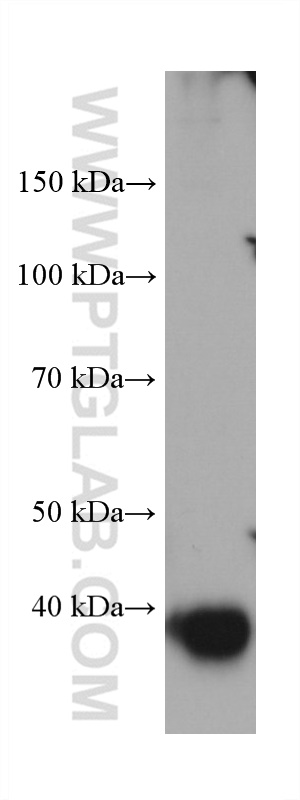验证数据展示
经过测试的应用
| Positive WB detected in | mouse cerebellum tissue, mouse brain tissue, SH-SY5Y cells |
推荐稀释比
| 应用 | 推荐稀释比 |
|---|---|
| Western Blot (WB) | WB : 1:5000-1:50000 |
| It is recommended that this reagent should be titrated in each testing system to obtain optimal results. | |
| Sample-dependent, Check data in validation data gallery. | |
发表文章中的应用
| WB | See 1 publications below |
| IHC | See 1 publications below |
产品信息
66931-1-Ig targets Kir4.1 in WB, IHC, ELISA applications and shows reactivity with Human, Mouse samples.
| 经测试应用 | WB, ELISA Application Description |
| 文献引用应用 | WB, IHC |
| 经测试反应性 | Human, Mouse |
| 文献引用反应性 | mouse |
| 免疫原 |
CatNo: Ag16785 Product name: Recombinant human KCNJ10 protein Source: e coli.-derived, PET28a Tag: 6*His Domain: 224-426 aa of BC034036 Sequence: ETIRFSQHAVVASHNGKPCLMIRVANMRKSLLIGCQVTGKLLQTHQTKEGENIRLNQVNVTFQVDTASDSPFLILPLTFYHVVDETSPLKDLPLRSGEGDFELVLILSGTVESTSATCQVRTSYLPEEILWGYEFTPAISLSASGKYIADFSLFDQVVKVASPSGLRDSTVRYGDPEKLKLEESLREQAEKEGSALSVRISNV 种属同源性预测 |
| 宿主/亚型 | Mouse / IgG1 |
| 抗体类别 | Monoclonal |
| 产品类型 | Antibody |
| 全称 | potassium inwardly-rectifying channel, subfamily J, member 10 |
| 别名 | BIRK 10, KCNJ10, KCNJ13 PEN, KIR1.2, Kir4.1 |
| 计算分子量 | 379 aa, 41 kDa |
| 观测分子量 | 40 kDa |
| GenBank蛋白编号 | BC034036 |
| 基因名称 | Kir4.1 |
| Gene ID (NCBI) | 3766 |
| RRID | AB_2882257 |
| 偶联类型 | Unconjugated |
| 形式 | Liquid |
| 纯化方式 | Protein G purification |
| UNIPROT ID | P78508 |
| 储存缓冲液 | PBS with 0.02% sodium azide and 50% glycerol, pH 7.3. |
| 储存条件 | Store at -20°C. Stable for one year after shipment. Aliquoting is unnecessary for -20oC storage. |
实验方案
| Product Specific Protocols | |
|---|---|
| WB protocol for Kir4.1 antibody 66931-1-Ig | Download protocol |
| Standard Protocols | |
|---|---|
| Click here to view our Standard Protocols |
发表文章
| Species | Application | Title |
|---|---|---|
J Ovarian Res Ovarian tissue transplantation ameliorates osteoporosis and dyslipidaemia in ovariectomised mice | ||
Biochim Biophys Acta Mol Basis Dis Involvement of Kir4.1 in pain insensitivity of the BTBR mouse model of autism spectrum disorder |



